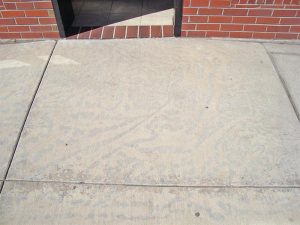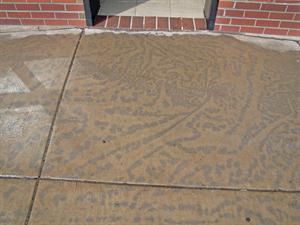Flatwork Discoloration
Flatwork Discoloration: Cause and Remedies
Folds and wrinkles in curing blankets become the location of water-evaporation and condensation cycles cuasing flatwork discoloration.
Question:
Last fall we placed a concrete sidewalk in front of a downtown office building. Because it was relatively cold weather, we used a winter flatwork mix and covered the slab with curing blankets after installing a light broom finish. We left the blankets on for seven days as required by the specifications. When we removed the blankets we noticed surface discolorations, but thought they would go away when the concrete dried. Now, seven months later, the owner is not happy with the strange pattern of discoloration. It’s not very noticeable when the concrete is dry, but it’s extremely visible when wet. What caused the surface discoloration? More importantly, is there anything we can do to remove it?
Answer:
Your surface discoloration was caused by nonuniform curing conditions. In your case, the uneven curing was caused by folds or wrinkles in the curing blankets. This form of discoloration is normally associated with clear polyethylene sheeting; however, it can happen with any type of waterproof sheeting.
Folds or wrinkles frequently create water evaporation-condensation cycles that cause light and dark areas to form on flatwork. Light areas occur where the blanket is in full contact with the concrete and a thin film of water forms between the blanket and concrete. Dark areas form where the blanket is not in full contact with the concrete, enabling surface evaporation to take place.
Flatwork discoloration can form as early as 16 hours after concrete placement.
Water evaporation and condensation

Water evaporating from the concrete pulls alkali salts from within the concrete to the surface, where they are deposited in the surface pores of the concrete. Because these deposits are relatively transparent and their optical behavior is similar to that of water or clear oil, they darken the color of the concrete surface.
Heat from the sun and the hydration of portland cement causes water to evaporate from the concrete. Water vapor then condenses on the cool, high portions of folds and wrinkles in the curing blanket. The water eventually runs down the sides of the blanket to collect and seal the surface of the concrete where the blanket is in contact with the surface. The thin film of water between the blanket and surface of the concrete does not allow water evaporation from the concrete to occur. Therefore, these areas are essentially free of alkali salt deposits as compared to areas below folds and wrinkles. (See illustration above.)
The use of calcium chloride as a chemical accelerator can exacerbate the problem by increasing the magnitude and permanence of the surface discolorations. Since a winter flatwork mix was used and considering the severity of the discolorations, most likely your concrete contained calcium chloride. As the dosage rate of the calcium chloride increases, the risk and severity of discolorations also increases.
How to remove discolorations

Intermittent washing, scrubbing, and drying should be your first approach. However, this remedy becomes less effective as concrete ages. For your project, it is probably too late to remove the discolorations by intermittent washing and drying.
If washing and drying doesn’t work, try ponding a 10% solution of sodium hydroxide on the concrete for one to two days and then thoroughly remove the caustic solution using lots of clean water. Sodium hydroxide (NaOH) is caustic soda, and available at hardware and building supply stores. Upon drying, the darker areas may blend better with the lighter areas. However, you may want to bypass this option due to the difficulties and risks associated with using an extremely caustic solution, such as the need for protective clothing and equipment.
The best option to consider consists of washing the concrete with a very mild acid such as diammonium citrate, (NH4)2 HC6H5O7, more commonly known as ammonium citrate or ammonium citrate dibasic. Do not use strong acids such as hydrochloric (muriatic) since they typically etch away too much paste and expose too many aggregate particles.
Ammonium citrate is fairly safe to use and available from commercial chemical supply stores in powder or crystal form. This treatment consists of the following steps:
- Apply a 20% to 30% solution of ammonium citrate solution to the dry surface.
- Continuously and lightly brush the treated area to maintain a uniform film of clear liquid on the surface. The liquid will start to turn into a white gel in about 5 minutes. If needed, add more water so the gel does not stiffen or dry.
- Continue to stir and brush the gel around on the surface for about 15 minutes.
- With vigorous scrubbing, thoroughly clean all the gel from the surface with lots of clean water. If needed, repeat the treatment after the concrete has completely dried.
After treating the surface with ammonium citrate, intermittent wetting with clean water and drying may further improve the appearance. For a more uniform appearance, treat the entire slab with ammonium citrate. Be sure to test a small section before treating the entire slab to perfect the technique and to avoid unexpected results.
by Kim Basham



0 comments